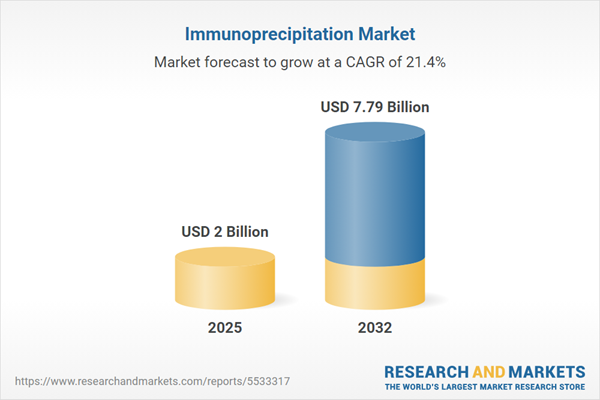Speak directly to the analyst to clarify any post sales queries you may have.
The immunoprecipitation market is entering a pivotal phase as evolving methods, global supply shifts, and integration with multi-omics research demand agile, informed decision-making. Leaders across biotech, pharma, and research are re-evaluating workflows to harness advanced reagents, automation, and strategic sourcing.
Market Snapshot: Immunoprecipitation Market Growth & Dynamics
The immunoprecipitation market grew from USD 1.64 billion in 2024 to USD 2 billion in 2025. It is forecasted to expand at a compound annual growth rate (CAGR) of 21.43%, reaching USD 7.79 billion by 2032.
This consistent growth is driven by increasing reliance on antibody-based assays for high-throughput protein analysis, the integration of automation, and expanding applications in proteomics and epigenetics.Scope & Segmentation
This report provides comprehensive coverage of the immunoprecipitation market, detailing key segments, technologies, and geographic regions shaping adoption and innovation:
- Antibody Types: Monoclonal (mouse monoclonal, rabbit monoclonal) and polyclonal (goat and rabbit polyclonal) antibodies for targeted and efficient protein capture.
- Product Formats: Agarose beads; magnetic bead technologies including paramagnetic and superparamagnetic variants for both traditional and automated workflows.
- End-User Profiles: Academic and research institutes, contract research organizations, pharmaceutical and biotechnology companies spanning basic research to clinical development.
- Application Areas: Epigenetics, post-translational modification studies, and broader protein analysis to address diverse experimental objectives.
- Regional Coverage: Americas (North and Latin America), Europe, Middle East & Africa (including subregions and key markets), and Asia-Pacific (driven by rising investments and manufacturing capabilities).
- Leading Companies: Covers developments from Thermo Fisher Scientific Inc., Merck KGaA, Danaher Corporation, Bio-Rad Laboratories, Inc., Abcam plc, Bio-Techne Corporation, QIAGEN N.V., Becton, Dickinson and Company, PerkinElmer, Inc., and GenScript Biotech Corporation.
Key Takeaways for Market Leaders
- Recombinant antibody technologies and next-generation bead chemistries are catalyzing greater assay sensitivity and workflow automation, fostering integration with precision research platforms.
- Differentiated antibody and bead offerings are enabling tailored immunoprecipitation solutions, meeting the needs of complex protein interaction and epigenetic studies.
- Automation, digital data capture, and standardized protocols are paving the way for higher reproducibility, scalability, and seamless multi-omics adoption.
- Regional investment patterns and collaborative networks, particularly in North America, Europe, and Asia-Pacific, are setting benchmarks for innovation and operational excellence.
- Partnering between reagent suppliers and contract research organizations is expanding market reach and supporting turnkey assay solutions for clients.
Tariff Impact and Supply Chain Adaptation
Recent changes to United States tariff policies have impacted sourcing costs and logistics for immunoprecipitation reagents. Increased duties on imported antibodies and bead substrates from international suppliers have raised prices and led to longer delivery timelines. Stakeholders are responding by diversifying supplier portfolios, establishing domestic production, and enhancing inventory management strategies. Collaborative efforts among regulators, industry consortia, and research organizations aim to stabilize access and enable sustained laboratory operations.
Primary Keyword: Immunoprecipitation Market
The immunoprecipitation market report evaluates shifts in technology, sourcing, and workflows to help stakeholders maintain agility and resilience in a rapidly evolving landscape.
Methodology & Data Sources
Insights are derived from rigorous secondary research—reviewing peer-reviewed literature, patents, technical white papers, company reports, and regulatory filings—complemented by primary interviews with scientific, commercial, and operational leaders from the academic, industrial, and contract sectors. Triangulation of quantitative adoption metrics and qualitative input ensures reliable, actionable market intelligence.
Why This Report Matters
- Supports strategic planning with actionable intelligence on technology shifts, supply chain dynamics, and best practices in antibody and bead selection.
- Enables informed sourcing and procurement decisions amid global trade and tariff fluctuations, supporting operational continuity and cost management.
- Guides investment in automation and workforce development for competitive differentiation in immunoprecipitation applications.
Conclusion
The immunoprecipitation market is positioned at the intersection of innovation, global supply adaptation, and specialized research needs. This report equips senior decision-makers to respond confidently to change and capture evolving opportunities in protein analysis and multi-omics research.
Additional Product Information:
- Purchase of this report includes 1 year online access with quarterly updates.
- This report can be updated on request. Please contact our Customer Experience team using the Ask a Question widget on our website.
Table of Contents
3. Executive Summary
4. Market Overview
7. Cumulative Impact of Artificial Intelligence 2025
Companies Mentioned
The companies profiled in this Immunoprecipitation market report include:- Thermo Fisher Scientific Inc.
- Merck KGaA
- Danaher Corporation
- Bio-Rad Laboratories, Inc.
- Abcam plc
- Bio-Techne Corporation
- QIAGEN N.V.
- Becton, Dickinson and Company
- PerkinElmer, Inc.
- GenScript Biotech Corporation
Table Information
| Report Attribute | Details |
|---|---|
| No. of Pages | 198 |
| Published | October 2025 |
| Forecast Period | 2025 - 2032 |
| Estimated Market Value ( USD | $ 2 Billion |
| Forecasted Market Value ( USD | $ 7.79 Billion |
| Compound Annual Growth Rate | 21.4% |
| Regions Covered | Global |
| No. of Companies Mentioned | 11 |









